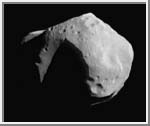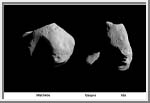











|
Asteroid 253
On June 27, 1997 the Near-Earth Asteroid Rendezvous (NEAR) spacecraft flew past asteroid 253 Mathilde. NEAR was the first mission of NASA's low-cost discovery missions and the first discovery spacecraft to return scientific data from an encounter. The primary mission of NEAR is an encounter with the asteroid 433 Eros in February 1999. The encounter with Mathilde was frought with difficulty. A year before the launch mission designers discovered that NEAR would pass close to the asteroid Mathilde on its way to Eros. Should the trajecotry of NEAR be modified to encounter Mathilde and use some of the precious fuel needed for the Eros encounter? Scientists were also concerned about possible dust particles damaging the spacecraft as NEAR and Mathilde crossed paths at a speed of 10 kilometers per second.
Previous to the encounter, very little was know about Mathilde. It was discovered by Johanna Palisa on November 12, 1885 in Vienna, Austria. Mathilde is a very unusual asteroid. It has an extreamly long rotation peroid of 415 hours. Only two other asteroids (1220 Clocus and 288 Glauke) are known to have longer rotation peroids. Mathilde is also one of the blackest objects in the solar system, reflecting only 3% of the light that strikes it. As one scientist said, "It is blacker than coal" or two times the darkness of a chunk of charcoal.
Mathilde is the largest asteroid to be visited by spacecraft. It is 52 kilometers (33 miles) in diameter and is approximately four times the size of Gaspra and two times the size of Ida. Ida and Gaspra were visited by the Galileo spacecraft on October 29, 1991 and August 28, 1993 respectively.
On June 27, 1997 NEAR made a spectatular 25 minute flyby of Mathilde which resulted in more than 500 images of a dark, crater-battered little world that dates to the beginning of the solar system. Mathilde is classified as a carbon rich C-type asteroid.
| Animation of Mathilde |
|---|
| Views of Mathilde |
|---|
 First Image of Asteroid 253 Mathilde
First Image of Asteroid 253 Mathilde
This first image of asteroid 253 Mathilde, returned by the NEAR
spacecraft just before 10:00 AM EDT on June 27, 1997, was taken
from a distance of 1800 kilometers (1120 miles). Sunlight is coming
from the upper right. The part of the asteroid shown is about 59
kilometers (36 miles) across, and the scale is approximately 230
meters (780 feet) per pixel. The surface is heavily cratered, and
the large shadowed area on the left may be a single impact gouge well
over 10 kilometers (6 miles) deep. The angular form of the edge of
the shadowed area suggests that large impacts may have spalled large
pieces off the asteroid. This asteroid is very dark, reflecting only
about 4% of the light falling on it, but was imaged easily by the
sensitive NEAR multispectral camera.
 Mosaic of Mathilde
Mosaic of Mathilde
This image mosaic of asteroid 253 Mathilde is constructed from four images acquired by the NEAR spacecraft on June 27,
1997. This was taken from a distance of 2,400 km (1,500 miles). Sunlight is coming from the upper right. The
part of the asteroid shown is about 59 by 47 km (36 by 29 miles) across. Details as small as 380 meters (1,250 feet)
can be discerned. The surface exhibits many large craters, including the deeply shadowed one at the center, which is estimated
to be more than 10 kilometers (6 miles) deep. The shadowed, wedge-shaped feature at the lower right is another large crater
viewed obliquely. The angular shape of the upper left limb of the asteroid results from the rim of a third large crater viewed
edge-on. The bright mountainous feature at the far left may be the rim of a fourth large crater emerging from the shadow.
The angular shape is believed to result from a violent history of impacts.
 Mathilde, Gaspra and Ida Comparison
Mathilde, Gaspra and Ida Comparison
These are views of the three asteroids that have been imaged at close range by spacecraft. The image of Mathilde (left) was
taken by the NEAR spacecraft on June 27, 1997. Images of the asteroids Gaspra (middle) and Ida (right) were taken by the
Galileo spacecraft in 1991 and 1993, respectively. All three objects are presented at the same scale. The visible part of
Mathilde is 59 km wide x 47 km high (37 x 29 miles). Mathilde has more large craters than the other two
asteroids. The relative brightness has been made similar for easy viewing; Mathilde is actually much darker than either Ida or Gaspra.
 Large Impact Crater on Mathilde
Large Impact Crater on Mathilde
This view of 253 Mathilde, taken from a distance of about 1,200 km (748 miles), was acquired shortly after the NEAR
spacecraft's closest approach to the asteroid. In this image, the asteroid has been rotated so that the
illumination appears to come from the upper left. This portion of Mathilde shows numerous impact craters, ranging from over 30 km to less than 0.5 km (18.. 0.3 miles) in diameter. Raised crater rims suggest that some of the material
ejected from these craters traveled only short distances before falling back to the surface; straight sections of some crater rims
indicate the influence of large faults or fractures on crater formation. The number of craters as a function of size, and the number
of each size within the visible area, are similar to values seen on asteroid 243 Ida, viewed by the Galileo spacecraft in 1993. A
major difference between Ida and Mathilde appears to be the abundance of very large craters: Mathilde has at least 5 craters
larger than 20 km in diameter on the roughly 60% of the body viewed during the encounter.
 Two Views of Mathilde
Two Views of Mathilde
Two different views of asteroid 253 Mathilde were obtained by the NEAR spacecraft on June 27, 1997. The image at left was
obtained as the spacecraft approached Mathilde with its camera pointed near the direction of the Sun; only a few of the
prominent ridges on Mathilde are illuminated. The visible area at left is 29 km (18 miles) high, and the phase angle (the
angle from Sun-Mathilde- spacecraft) is 136°. As the spacecraft receded from Mathilde, it observed the asteroid (about 60 km or 38
miles across) almost fully lit by the Sun at a phase angle of 43° (right image). Mathilde's irregular shape results
from a long history of severe collisions with smaller asteroids. The largest visible crater is 30 km (19 miles) in diameter.